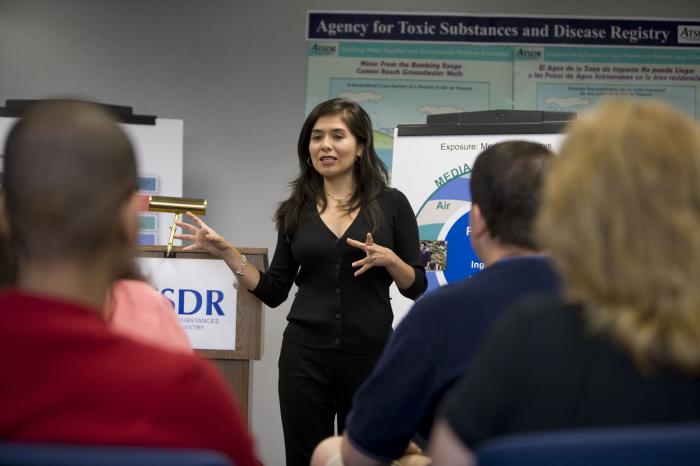 No matter what type of job you are interviewing for, you may be asked to give a seminar or presentation. When I interviewed for my first HR job, I had to give a presentation on any topic I wanted. Other jobs specify that you need to give a presentation on a topic specifically related to the job. In my case, they were looking for both presentation skills and my ability to teach. When asked to present on a job-related topic, a potential employer may be looking for your ability to organize information and your knowledge on the topic. Presentations can be scary, but some good old-fashioned preparation can make things go much more smoothly.
No matter what type of job you are interviewing for, you may be asked to give a seminar or presentation. When I interviewed for my first HR job, I had to give a presentation on any topic I wanted. Other jobs specify that you need to give a presentation on a topic specifically related to the job. In my case, they were looking for both presentation skills and my ability to teach. When asked to present on a job-related topic, a potential employer may be looking for your ability to organize information and your knowledge on the topic. Presentations can be scary, but some good old-fashioned preparation can make things go much more smoothly.
In order to prepare, you need to know what your audience is looking for. Read on for some things to avoid during your presentation.
Don’t Pick an Unfamiliar Topic
Your audience will expect you to be well versed on the subject you are presenting. Don’t pick a topic you are interested in but haven’t started researching yet. If you can, give a presentation you have already given. Tweak it to fit your audience and/or the presentation requirements. You will probably get questions so broad knowledge on the topic is necessary.
Don’t Ignore the Timeline
If you are given a time limit for the presentation, make sure you stick to that. If you were not given a presentation time limit, ask. Practice your speech in front of a mirror or with a friend while timing yourself and then edit your presentation until you reach time limit reliably. Be sure to leave a minute or two for questions.
Don’t Rely on Your Slides
Watching someone stare at the projector screen and read a slide word-for-word is about as interesting as watching grass grow. If you use PowerPoint (this may or may not be necessary), use the slides as visuals to go along with your presentation, not a script. Keep the words on your slide to a minimum and use pictures and graphs to get your point across. Be sure to proofread your slides for accuracy.
Don’t Just Stand There (Do Something!)
In many situations, your body language can be just as important as the words you say – and presentations are no exception. Practice using hand gestures to emphasize key points but stay aware of what your hands are doing—fiddling with a pen or your hair can be very distracting. If you are given the option to sit or stand for your presentation, I recommend standing. You will look more in control and comfortable standing versus sitting and hiding behind a podium. Don’t be afraid to smile during your presentation, you may find it will help put you at ease.
Don’t Ignore the Audience
The audience can help you gauge where you need to go with your presentation. Pay attention to their faces and body language. Do they seem confused? Bored? Enthralled? If you know your material well enough, you can use subtle cues from the audience to redirect your presentation if necessary. If everyone seems confused, expand on the topic and ask if anyone has questions. If they are enthralled, keep doing what you are doing!
Don’t Fail to Explain Your Role
One of the biggest critiques I hear from hiring managers is that they are left wondering what role the candidate played in the project he was presenting. Were you leading this project or were you in a supporting role? In either case, be honest and explain the work you did and how your work led to the success of the project.
Don’t Give Away Trade Secrets
Don’t violate your confidentiality contracts and use common sense. Enough said.
Don’t Forget to Sum it Up
Your presentation should have a beginning, a middle and an end and you should be telling a story throughout. Spend some time thinking of a strong introduction with a “hook” that will get your audience engaged. At the end, make sure to tell the audience why your presentation matters. Pull the threads of the story together and answer the question the audience member is asking: “why do I care?”. Remember, the presentation is more than just spewing facts or presenting colorful graphs.
I think I’m starting to sound like a broken record, so forgive me, but the most important thing you can do is prepare. Your audience will appreciate a well thought-out, well rehearsed presentation and a happy audience leads to job offers.
Becca McKnight
Latest posts by Becca McKnight (see all)
- Move from Fear to Balance by Asking Yourself the Right Questions - April 10, 2020
- Pop Quiz: What Scientific Job is Right for You? - October 18, 2019
- Trying New Ways to Manage Pain - April 28, 2017

Along with hand-fiddling, practice using your laser pointer. Use it to guide the audience member’s eye for key points. Avoid tracing every word or excessively circling. One tip for extra nervous hands (which makes your laser pointer shaky on the screen) is to hold the pointer gently with both hands and somewhat close to your body. Alternatively, if using PowerPoint, you can make the arrow visible throughout the whole presentation and use the mouse instead of a pointer.
Those are great tips, thanks Karen!